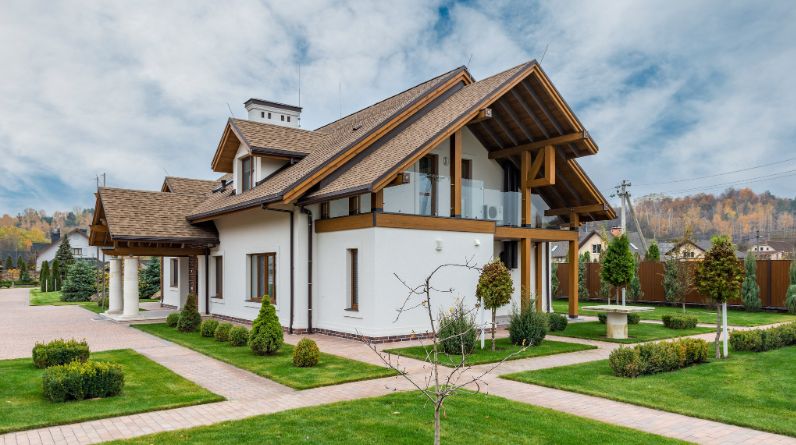
Owning a home is a huge achievement, and protecting it is critical. Homeowners insurance acts as a castle’s shield, providing financial protection against unexpected catastrophes that could damage or destroy your house. In this complete article, we look at the basics of homeowners insurance, coverage specifics, a well-known provider, and how to locate the cheapest homeowners insurance.
Understanding Homeowners Insurance: A Fortress for Your Home
Homeowners insurance is a financial safety net that protects your home and belongings from a variety of risks. Fire, theft, vandalism, and natural calamities are common causes of destruction. Furthermore, it provides liability coverage, which provides financial protection in the event that someone is injured on your property.
What Does Homeowners Insurance Cover?
Homeowners insurance covers a variety of situations, ensuring comprehensive protection for your home. The coverage typically includes:
1. Dwelling Coverage:
Dwelling coverage is the foundation of homeowners insurance, covering the cost of repairing or rebuilding your house if it is damaged or destroyed by a covered risk. This component contains not just the main structure, but also any attached structures, such as garages, and other integrated features that contribute to the overall structure of the home. This means that in the unfortunate event of a fire, storm, or other covered occurrence, your policy may cover the cost of restoring or reconstructing your house, allowing you to restore your safety and comfort.
2. Personal Property Coverage:
Personal property insurance is intended to protect your valuables in your house. This includes furniture, clothing, electronics, and other personal stuff. This coverage kicks in when covered events like theft, vandalism, or damage caused by defined risks occur. It offers financial support to repair or replace your personal belongings, allowing you to recover from losses and retain your quality of life even in the aftermath of unanticipated occurrences.
3. Liability Coverage:
Liability coverage, which provides protection beyond physical structures, is an important component of homes insurance. If someone is wounded on your property and you are found to be at fault, liability insurance becomes critical. It pays for legal fees related with future litigation as well as the injured party’s medical bills. This protects you financially in circumstances when your culpability is established, giving you a sense of security and peace of mind.
4. Additional Living Expenses (ALE):
Additional Living Expenses (ALE) is a useful feature of homeowners insurance that kicks in when your house is become uninhabitable as a result of a covered incident. In such circumstances, ALE pays for the increased costs of temporary living accommodations. This includes costs such as hotel stays, rentals, and other accommodations required to maintain your level of living while your house is being rebuilt. ALE lessens the financial strain of obtaining alternate homes during the restoration time.
5. Other Structures Coverage:
Many homes feature auxiliary constructions such as detached garages, sheds, or even isolated workshops in addition to the main house. Coverage for other structures guarantees that these peripheral pieces are also covered. This coverage kicks in if these structures are damaged by a covered risk, such as a storm or fire. It ensures that your insurance policy bears the financial burden of repairing or rebuilding these detached structures, giving comprehensive coverage for all components of your property.
Navigating Policy Types: Tailoring Protection to Your Needs
In the intricate world of insurance, getting the proper coverage is like finding the perfect tailored suit. This book delves into the complexities of various insurance types, assisting you in navigating the many offers to get protection that is perfectly tailored to your specific needs.
1. HO-3 Policy: The Standard Guardian
The most prevalent and comprehensive type of homeowners insurance is the HO-3 coverage. It provides comprehensive coverage for your home, personal property, and liability. While it covers a variety of perils, it is crucial to note that it often does not cover floods or earthquakes.
2. HO-4 Policy: Renter’s Insurance
Renter’s insurance, often known as a HO-4 policy, is intended for tenants. It protects personal belongings, responsibility, and additional living expenses if the rented space becomes uninhabitable. While it does not include home insurance, it is an important safeguard for renters.
3. HO-5 Policy: Deluxe Protection
The HO-5 policy is similar to the HO-3 policy in terms of protection, but it includes more personal property coverage. It is sometimes seen as a deluxe or premium choice, providing more comprehensive security for your things.
4. HO-6 Policy: Condo Insurance
The HO-6 policy, designed for condominium owners, covers the inside of the condo unit, personal property, and liability. This policy focuses on individual unit coverage because condo owners share structural insurance with the condo organisation.
Cheapest Homeowners Insurance: How To Find One
While homeowners insurance is a necessary investment, finding the most economical choice is also critical. Here are some tips for finding the lowest homeowners insurance:
1. Shop Around:
Comparing homes insurance quotes is a critical step in obtaining the finest coverage at the most reasonable rates. Insurance costs can vary dramatically between carriers, and accepting the first quotation you receive may mean foregoing possible savings. Take the time to investigate several insurance companies’ products, comparing not only the pricing but also the coverage details. This thorough approach guarantees that you make an informed decision, matching your insurance to your demands as well as your budget.
2. Bundle Your Policies:
Bundling policies is a strategic strategy to save money on your insurance costs. When you combine your homeowners insurance with other policies, such as auto insurance, many insurers provide savings. This method not only streamlines your administrative responsibilities by unifying policies under one supplier, but it also saves you money. Bundling allows you to obtain savings and potentially lower the entire cost of your insurance coverage, making it a sensible and cost-effective option for homeowners.
3. Raise Your Deductible:
Increasing your deductible is a subtle approach for lowering your homeowners insurance price. A greater deductible usually leads in a lower premium, but there must be a balance. While choosing a higher deductible will lower your overall insurance rates, it’s also critical to ensure that the deductible you choose is one you can easily cover in the case of a claim. This method combines financial caution with cost-cutting initiatives to provide homes with a customised balance.
4. Home Security Measures:
Improving your home’s security features not only protects it from potential threats, but it can also result in substantial insurance savings. Installing alarm systems, deadbolts, and other security measures may qualify you for insurance rate discounts. Insurance providers see these preemptive actions as risk-mitigation strategies, recognising the lower possibility of occurrences such as theft or vandalism. By investing in home security, you not only improve the protection of your house, but you also gain possible financial benefits from lower insurance prices.
5. Maintain Good Credit:
Your credit score has a big impact on the cost of your homeowners insurance. Maintaining a solid credit score helps to cut insurance costs because it demonstrates financial responsibility. Regularly checking and aggressively maintaining your credit score will help you secure lower insurance prices. You present yourself as a lower-risk policyholder by demonstrating financial stability, creating trust with insurance providers and potentially unlocking more cheap insurance options.
6. Review and Update Your Policy:
Home and living conditions vary, and your insurance policy should appropriately reflect these changes. Regularly evaluating your policy guarantees that you are not paying for coverage that you do not use and that your coverage is current. Renovations, additions, or changes in the value of your things can all have an influence on your insurance needs. By updating your insurance on a regular basis, you ensure that your coverage stays current and cost-effective, preventing potential overpayment for superfluous coverage. This practise is essential for keeping a personalised and effective homeowners insurance policy.
Conclusion
As we conclude our exploration into homeowners insurance, one thing becomes crystal clear: your house is more than just a building; it’s your castle, your shelter. In this context, homeowners insurance is more than just a policy; it is a protector of dreams and memories. It serves as a fortress against unforeseen challenges, from the physical structure to the treasured possessions within. The world of insurance may appear complicated, but the prize is immeasurable: a safe haven in which to live, grow, and make lifelong memories. So, invest carefully, defend your castle, and enjoy the peace of mind that comes with a secure house.
Frequently Asked Questions (FAQs)
1. What is the purpose of homeowners insurance?
Homeowners insurance protects your house and belongings from a variety of dangers by providing financial coverage for damages caused by incidents such as fire, theft, or natural disasters. It also includes liability insurance, which protects you from financial losses if someone is injured on your premises.
2. Can homeowners insurance cover natural disasters?
Yes, depending on the coverage, homeowners insurance can cover damage caused by natural catastrophes such as hurricanes, tornadoes, and earthquakes. Coverage may vary, and additional policies may be necessary for certain events.
3. Is homeowners insurance mandatory?
While it is not required by law, most mortgage lenders require homeowners to get insurance. It’s an important part of being a responsible homeowner, as it protects both the homeowner and the lender’s investment.
4. How often should I review my homeowner’s insurance policy?
It is recommended that you evaluate your homeowner’s insurance coverage at least once a year and anytime there are substantial changes to your property or life circumstances. Regular assessments guarantee that your coverage meets your current requirements.
5. What factors determine the cost of homeowners insurance?
The location of your property, its age, the level of coverage, your credit score, and the installation of security measures are all factors that influence the cost of homeowners insurance. Premiums for homes in high-risk areas or with high-value assets may be higher.
6. Are there ways to lower homeowner insurance premiums?
Yes, there are ways to reduce homeowners insurance premiums. Bundling policies, raising your deductible, keeping good credit, installing security measures, and evaluating and updating your policy on a regular basis are all examples.
7. Does homeowner’s insurance cover home-based businesses?
While homes insurance covers some commercial equipment, it may not cover liability or other company-specific hazards. Additional company insurance or a rider may be required for comprehensive coverage.
8. Can I get homeowners insurance if I have a history of claims?
It is possible to obtain homeowners insurance with a claim history, but it may be difficult. Insurance companies may view you as a larger risk, resulting in higher premiums. Shopping around and dealing with an independent insurance agent can assist in locating appropriate solutions.
9. Is flood insurance included in homeowners insurance?
No, basic homeowners insurance does not often cover flood damage. Flood insurance is a separate policy that homeowners in flood-prone areas may consider acquiring if they want extra protection.
10. How does the claims process work for homeowners insurance?
Contacting your insurer promptly, documenting the damage, making interim repairs to prevent more damage, preparing for inspection, and working closely with your insurer to settle the claim are all part of the claims process for homeowners insurance. The procedure is designed to provide a fair and efficient resolution to your claim.





